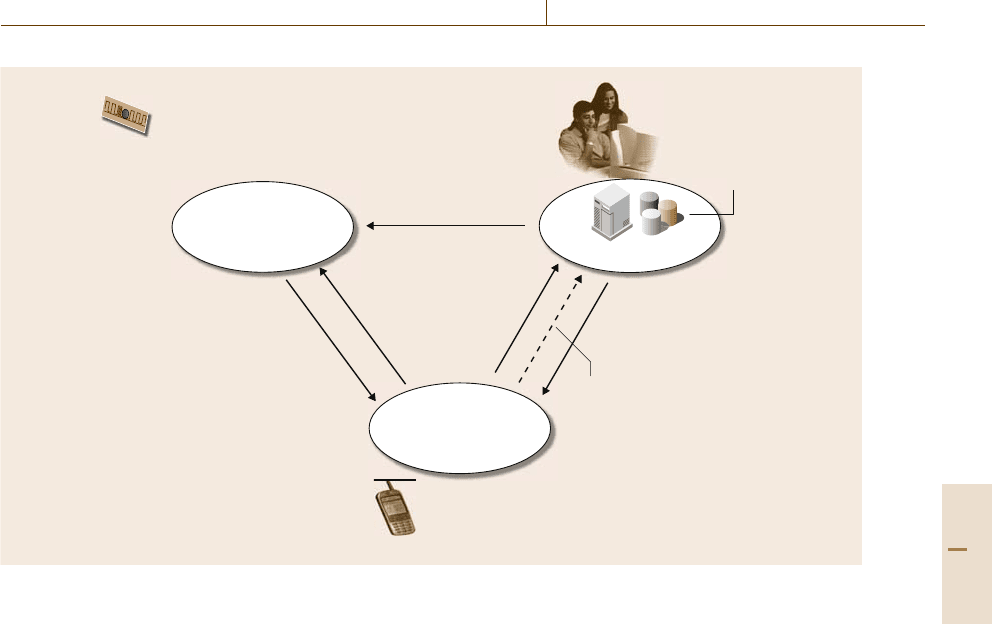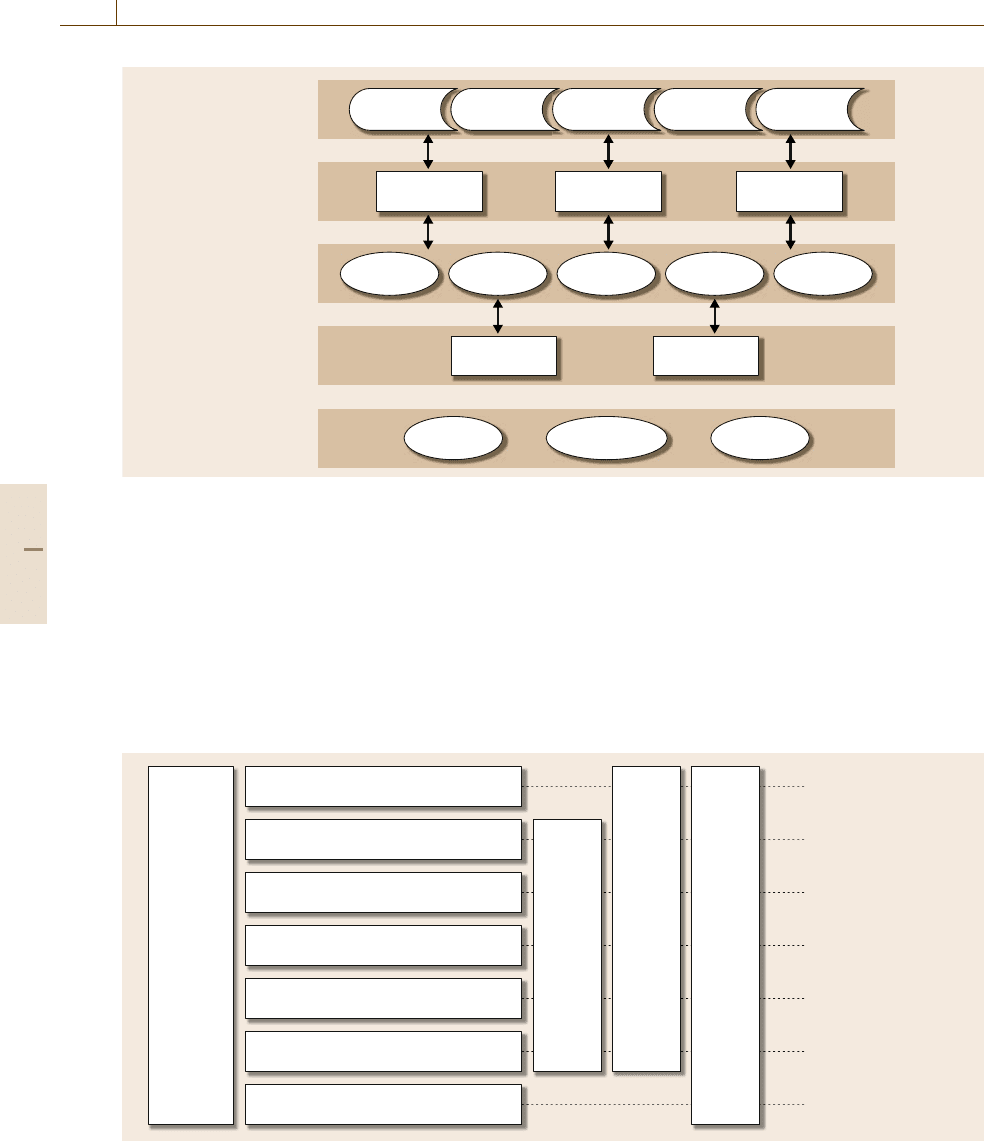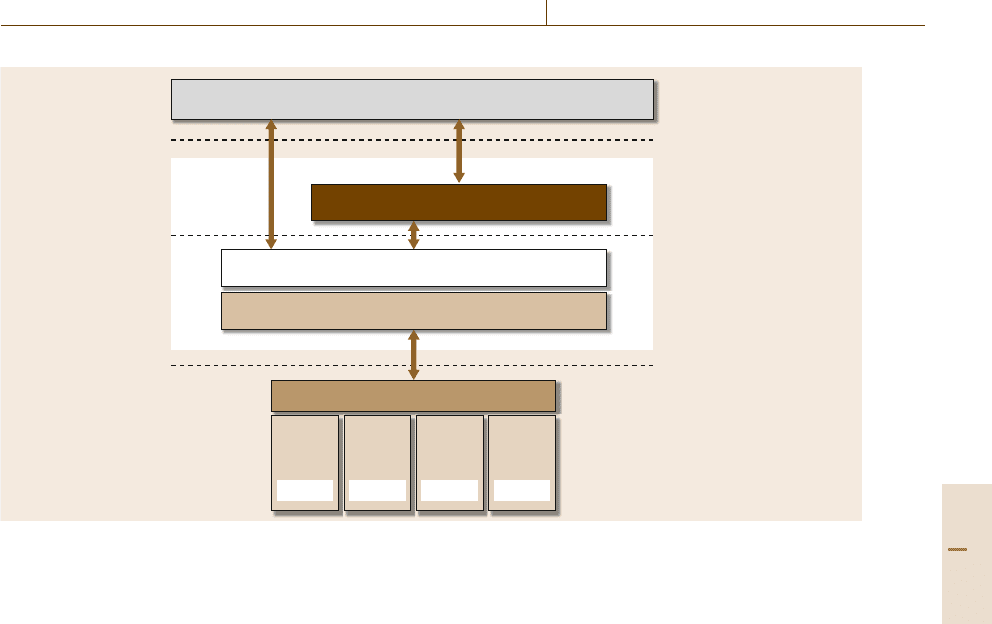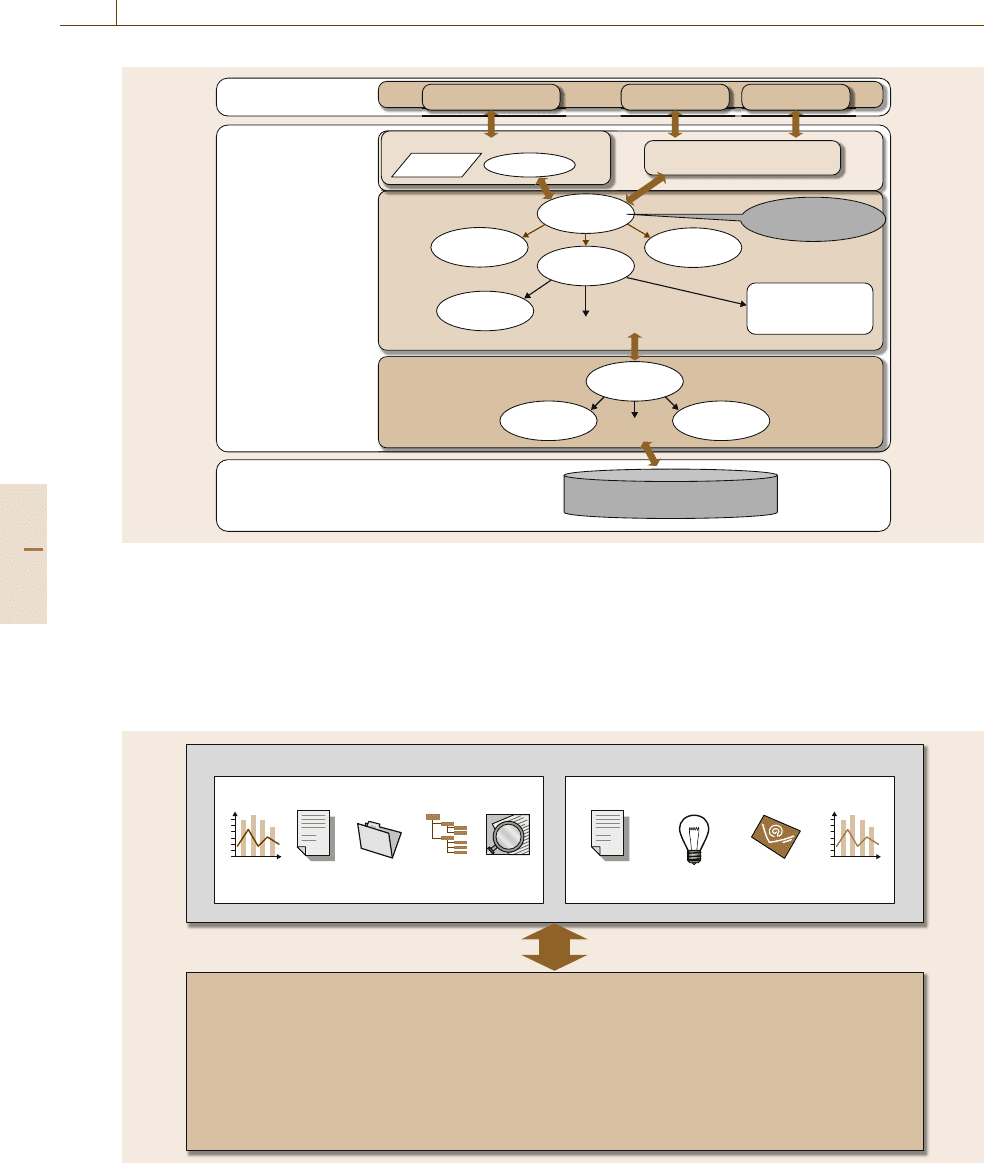Nof S.Y. Springer Handbook of Automation
Подождите немного. Документ загружается.


Reliability, Maintainability, and Safety 42.4 Challenges, Trends, and Open Issues 745
extrapolation, prognostics can be used to evaluate the
time when the drift will exceed a threshold and to pro-
pose a time before next potential failure. In this way,
proactive maintenance can optimize maintenance ac-
tions and planning in order to minimize production
downtime.
Proactive maintenance allows a maintenance ac-
tion improvement (mean availability), to follow the
degradation tendency (quality of service), to avoid the
occurrence of dangerous situations (safety), and finally
to support the operator with knowledge oriented to the
degradation cause and effect (maintainability).
e-Maintenance is an organizational point of view
of maintenance. The concept of e-Maintenance comes
from remote maintenance capabilities coupled with
information and communication capabilities. Remote
maintenance was first a concept of remote data acquisi-
tion orconsultation. Data are accessible during a limited
time. In order to realize e-Maintenance objectives data
storage must be organized to allow flexible access to
historical data.
In order to improve remote maintenance, a new con-
cept of e-Maintenance emerged at the end of the 1990s.
The e-Maintenance concept integrates cooperation, col-
laboration, and knowledge-sharing capabilities in order
to evolve the existing maintenance processes and to try
to tend towards new enterprise concepts: extended en-
terprise, supply-chain management, lean maintenance,
distributed support and expert centers, etc. Based on
web technologies, the e-Maintenance concept is nowa-
days available and industrial e-Maintenance software
platforms exist. e-Maintenance platforms (sometimes
termed asset management systems) manage the whole
of the maintenance processes throughout the system
lifecycle from engineering, maintenance, logistic, expe-
rience feedback,maintenance knowledge capitalization,
optimization, etc. to reengineering and revamping.
e-Maintenance is not based on software functions but
on maintenance services that are well-defined, self-
contained, and do not depend on the context or state of
other services. So, with the advent of service-oriented
architectures (SOA) and enterprise service-bus tech-
nologies [42.45], e-Maintenance platforms are easy
to evolve and can provide interoperability, flexibility,
adaptability, and agility. e-Maintenance platforms are
akindofhub for maintenance services based on exist-
ing, new, and future applications.
42.3.4 Industrial Applications
Industrial software platforms have been developed dur-
ing the 1990s in order to provide the proof of concept
of this RMS modeling framework before marketing off-
the-shelf products. The first applications have appeared
since 2000 in various sectors such as power energy, steel
factory, petrochemicalprocess, navy logisticsand main-
tenance support, nuclear fuel manufacturing and waste
treatment, etc.
A common objective of these multisector applica-
tions is to reduce operation costs by increasing the
availability, maintainability, and reliability of plants and
systems, and to facilitate their compliance with regu-
lation laws. Another common objective is to elicit and
save the implicit knowledge acquired by skilled oper-
ators as well as by skilled engineers when performing
their tasks.Others objectives are specific to anindustrial
sector; forexample, understanding complex phenomena
to anticipate maintenance operations is critical to opti-
mize the impact of shutdown and startup operations in
process plants [42.46].
Return on investment is estimated to be at most
1year from these industrial experiments, and leads to
a distributed service-oriented e-Maintenance infrastruc-
ture to warrantee by contract a level of availability in
plant operation (Fig.42.8).
42.4 Challenges, Trends, and Open Issues
All aspects of dependability such as reliability, main-
tainability, and safety should be viewed in a broader
context depending on both management and technical
processes within the enterprise system to ensure the
necessary resilience to intrinsic and extrinsic complex
phenomena occurring when systems are operating in
changing environments. For example, MTBF is a mea-
sure of the random nature of an event and does not
predict when something will fail but only predicts the
probability that a system will fail within a certain time
boundary. Contrary to conventional wisdom, accidents
often result from interactions between perfectly func-
tioning components, i.e., before a system has reached
its expected life as predicted by RMS analysis.
Such considerations underscore that other advanced
concepts are beyond traditional RMS analyses and the
individual mind-set of each engineering discipline to
cope with emergent behavior as one of the results of
complexity. In other words, dependability assumes that
cause–effect relationships can be ordered in known and
Part E 42.4

746 Part E Automation Management
knowable ways, while resilience [42.47] should con-
fine the contextual emergence of complex relationships
within the system and between the system and its envi-
ronment in unordered ways [42.48].
An initial challenge is to understand that the con-
cept of system as the unique result of normal emergence
within a collaborative systems engineering process
leads to an ad hoc solution based on heuristics and nor-
mative process-driven guidelines [42.49].
A second challenge relies on weak emergence
[42.50] to perceive, model, and check added behaviors
due to the interactions between the component sys-
tems. This should be led by extensive model-driven
requirements analysis adding more details than current
practices and complementary experiments such as mul-
tiagent simulation to track self-organizing patterns in
order to improve component systems’ adaptability.
A third open challenge deals with the quality of
the engineering process to determine whether a system
can survive a strongly emergent event, as well as the
adaptability of the whole enterprise to come into play in
facing an inevitable systemic instability.
References
42.1 T.L. Johnson: Improving automation software de-
pendability: a role for formal methods?, Control
Eng. Pract. 15(11), 1403–1415 (2007)
42.2 J. Stark: Handbook of Manufacturing Automation
and Integration (Auerbach, Boston 1989)
42.3 R.S. Dorf, A. Kusiak: Handbook of Design, Manu-
facturing and Automation (Wiley, New York 1994)
42.4 A. Ollero, G. Morel, P. Bernus, S.Y. Nof, J. Sasi-
adek, S. Boverie, H. Erbe, R. Goodall: From MEMS
to enterprise systems, IFAC Annu. Rev. Control 26(2),
151–162 (2002)
42.5 S.Y. Nof, G. Morel, L. Monostori, A. Molina, F. Filip:
From plant and logistics control to multi-enterprise
collaboration, IFAC Annu. Rev. Control 30(1), 55–68
(2006)
42.6 G. Morel, P. Valckenaers, J.M. Faure, C.E. Pereira,
C. Diedrich: Manufacturing plant control challenges
and issues, IFAC Control Eng. Pract. 15(11), 1321–1331
(2007)
42.7 A. Avizienis, J.C. Laprie, B. Randell, C. Landwehr:
Basic Concepts and Taxonomy of Dependable and
Secure Computing, IEEE Trans. Dependable Secur.
Comput. 1(1), 11–33 (2004)
42.8 S.E. Rigdon, A.P. Basu: Statistical Methods for the
Reliability of Repairable Systems (Lavoisier, Paris
2000)
42.9 J. Moubray: Reliability-Centered Maintenance (In-
dustrial, New York 1997)
42.10 A. Avizienis, J.C. Laprie, B. Randell: Fundamental
concepts of dependability, LAAS Techn. Rep. 1145,
1–19 (2001), http://www.laas.fr
42.11 J.W. Foster, D.T. Philips, T.R. Rogers: Reliability
Availability and Maintainability: The Assurance
Technologies Applied to the Procurement of Pro-
duction Systems (MA Press, 1979)
42.12 M. Pecht: Product Reliability, Maintainability and
Supportability Handbook (CRC, New York 1995)
42.13 H. Erbe: Technologies for cost-effective automation
in manufacturing, IFAC Professional Briefs (2003)
pp. 1–32
42.14 IEEE: IEEE Standard Computer Dictionary: A Compi-
lation of IEEE Standard Computer Glossaries (IEEE,
1990), http://ieeexplore.ieee.org/xpls/abs_all.jsp?
tp=&isnumber=4683&arnumber=182763&
punumber=2267
42.15 D. Kumar, J. Crocker, J. Knezevic, M. El-Haram: Re-
liability, Maintenance and Logistic Support. A life
Cycle Approach (Springer, Berlin, Heidelberg 2000)
42.16 IEC 61508: Functional safety of electrical/electronic/
programmable electronic (E/E/PE) safety-related
systems
42.17 T. Nakagawa: Maintenance Theory of Reliability
(Springer, London 2005)
42.18 W.E. Deming: Out of the Crisis: For Industry, Gov-
ernment, Education (MIT Press, Cambridge 2000)
42.19 C.G. Cassandras, S. Lafortune: Introduction to Dis-
crete Event Systems (Kluwer Academic, Norwell
1999)
42.20 F. Lhote, P. Chazelet, M. Dulmet: The extension of
principles of cybernetics towards engineering and
manufacturing, Annu. Rev. Control 23(1), 139–148
(1999)
42.21 N. Viswanadham, Y. Narahari: Performance Mod-
eling of Automated Manufacturing Systems
(Prentice-Hall, Englewood Cliffs 1992)
42.22 http://www.sei.cmu.edu/cmmi
42.23 http://www.oooneida.info
42.24 M.C. Paulk: How ISO 9001 compares with the CMM,
IEEE Softw. 12(1), 74–83 (1995)
42.25 K. Polzer: Ease of use in engineering – availability
and safety during runtime, Autom. Technol. Pract.
1, 49–60 (2004)
42.26 T. Shell: Systems functions implementation and
behavioural modelling: system theoretic approach,
Int. J. Syst. Eng. 4(1), 58–75 (2001)
42.27 A. Moik: Engineering-related formal method for
the development of safe industrial automation
systems, Autom. Technol. Pract. 1, 45–53 (2003)
42.28 E.M. Clarke, O. Grunberg, D.A. Peled: Model Check-
ing (MIT Press, Cambridge 2000)
Part E 42

Reliability, Maintainability, and Safety References 747
42.29 J.R. Abrial: The B Book: Assigning Programs to
Meanings (Cambridge Univ. Press, Cambridge 1996)
42.30 T. Kim, D. Stringer-Calvert, S. Cha: Formal verifica-
tion of functional properties of a SCR-style software
requirements specification using PVS, Reliab. Eng.
Syst. Saf. 87, 351–363 (2005)
42.31 J. Yoo, T. Kim, S. Cha, J.-S. Lee, H.S. Son: A for-
mal software requirements specification method
for digital nuclear plant protection systems, Syst.
Softw. 74(1), 73–83 (2005)
42.32 S. Elkhattabi, D. Corbeel, J.C. Gentina: Integra-
tion of dependability in the conception of FMS, 7th
IFAC Symp. on Inf. Control Probl. Manuf. Technol.,
Toronto (1992) pp. 169–174
42.33 R.Vogrig,P.Baracos,P.Lhoste,G.Morel,B.Salze-
mann: Flexible manufacturing shop, Manuf. Syst.
16(3), 43–55 (1987)
42.34 E. Zamaï, A. Chaillet-Subias, M. Combacau: An
architecture for control and monitoring of dis-
crete events systems, Comput. Ind. 36(1–2), 95–100
(1998)
42.35 A.K.A. Toguyeni, E. Craye, L. Sekhri: Study of the
diagnosability of automated production systems
based on functional graphs, Math. Comput. Simul.
70(5–6), 377–393 (2006)
42.36 M.G. Mehrabi, A.G. Ulsoy, Y. Koren: Reconfigurable
manufacturing systems: key to future manufactur-
ing, J. Intell. Manuf. 11(4), 403–419 (2000)
42.37 ESPRIT II-2172 DIAS Distributed Intelligent Actuators
and Sensors
42.38 ESPRIT III-6188 PRIAM Pre-normative Requirements
for Intelligent Actuation and Measurement
42.39 ESPRIT III-6244 EIAMUG European Intelligent Actu-
ation and Measurement User Group
42.40 ESPRIT IV-23525 IAM-PILOT Intelligent Actuation and
Measurement Pilot
42.41 J.F. Pétin, B. Iung, G. Morel: Distributed intelligent
actuation and measurement system within an in-
tegrated shop-floor organisation, Comput. Ind. J.
37, 197–211 (1998)
42.42 http://www.predict.fr
42.43 http://www.openoandm.org
42.44 B. Iung, G. Morel, J.-B. Léger: Proactive main-
tenance strategy for harbour crane operation
improvement, Robotica 21,313–324(2003)
42.45 F.B. Vernadat: Interoperable enterprise systems:
Principles, concepts and methods, IFAC Annu. Rev.
Control. 31(1), 137–145 (2007)
42.46 D. Galara: Roadmap to master the complexity
of process operation to help operators improve
safety, productivity and reduce environmental im-
pact, Annu. Rev. Control 30, 215–222 (2006)
42.47 http://www.resilience-engineering.org
42.48 C.F. Kurtz, D.J. Snowden: The new dynamics of
strategy: sense-making in a complex and compli-
cated world, IBM Syst. J. 42(3), 462–483 (2003)
42.49 ISO/IEC 15288, http://www.incose.org
42.50
M. Bedau: Weak Emergence, Philosophical Per-
spectives: Mind, Causation and World,Vol.11
(Blackwell, Oxford 1997)
Part E 42
“This page left intentionally blank.”

749
Product Lifecy
43. Product Lifecycle Management
and Embedded Information Devices
Dimitris Kiritsis
The closed-loop product lifecycle management
(PLM) system focuses on tracking and managing
the information of the whole product lifecycle,
with possible feedback of information to prod-
uct lifecycle phases. It provides opportunities
to reduce the inefficiency of lifecycle operations
and gain competitiveness. Thanks to the ad-
vent of hardware and software related to product
identification technologies, e.g., radiofrequency
identification (RFID) technology, recently closed-
loop PLM has been highlighted as a tool of
companies to enhance the performance of their
business models. However, implementing the
PLM system requires a high level of coordination
and integration. In this chapter we present the
background methodologies and techniques and
the main components for closed-loop PLM and
how they are related to each other. We start with
the concept of closed-loop PLM and a system ar-
chitecture in Sect. 43.1.InSect.43.2 we describe
the necessary components for closed-loop PLM
and how to integrate and coordinate them with
respect to business models, hardware, and soft-
ware. In Sect. 43.3 we propose a development
guide based on experiences gathered from proto-
type applications developed to date. In Sect. 43.4
we introduce a real case example that imple-
ments a closed-loop PLM solution focusing on
43.1 The Concept of Closed-Loop PLM ............ 749
43.2 The Components
of a Closed-Loop PLM System................. 751
43.2.1 Product Embedded Information
Device (PEID)................................ 751
43.2.2 Middleware ................................. 753
43.2.3 Decision Support System (DSS)........ 753
43.2.4 Product Knowledge
and Management System (PDKM) ... 754
43.3 A Development Guide
for Your Closed-Loop PLM Solution ......... 755
43.3.1 Modeling .................................... 755
43.3.2 Selection of PEID System................ 756
43.3.3 Data and Data Flow Definition ....... 758
43.3.4 PDKM, DSS and Middleware ........... 759
43.4 Closed-Loop PLM Application ................. 761
43.4.1 ELV Information
andPEIDTechnology..................... 762
43.4.2 Decision Flow .............................. 762
43.5 Emerging Trends and Open Challenges ... 763
References .................................................. 764
end-of-life (EOL)ofvehicles(ELV). Finally,
Sect. 43.5 discusses some challenging issues
and emerging trends in the implementation
of closed-loop PLM.
43.1 The Concept of Closed-Loop PLM
Product lifecycle management (PLM) is a new strategic
approach to manage product-related information effi-
ciently over the whole product lifecycle. Conceived as
an extension to product data management (PDM), its
vision is to provide more product-related information
to the extended enterprise over the whole product life-
cycle. Its concept appeared in the late 1990s, moving
beyond the engineering aspects of a product and pro-
viding a shared platform for creation, organization, and
dissemination of product-related knowledge across the
extended enterprise [43.1]. PLM facilitates the inno-
vation of enterprise operations by integrating people,
processes, business systems, and information through-
out product lifecycle and across extended enterprise. It
Part E 43

750 Part E Automation Management
aims to derivethe advantagesof horizontallyconnecting
functional silos in organizations, enhancing informa-
tion sharing, efficient change management, use of past
knowledge, and so on [43.2]. To meet this end, a PLM
system should be able to monitorthe progress of a prod-
uct at any stage in its lifecycle, to analyze issues that
might arise at any product lifecycle phase, to make
suitable decisions to address problems, and to exe-
cute and enforce these decisions. In spite of its vision,
PLM as defined above has not received much atten-
tion so far from industry because there are no efficient
tools to gather product data over the entire product
lifecycle. However, recent applications of product iden-
tification technologies in various PLM aspects [43.3–9]
demonstrate that a sound technological framework is
now available for PLM to implement its vision. Prod-
uct identification technologies enable products to have
embedded information devices (e.g., RFID tags and on-
board computers), which makes it possible to gather
the whole lifecycle data of products at any time and
at any place. A new generation of PLM systems based
on product identification technologies will make the
whole product lifecycle totally visible and will allow
all actors involved in the product lifecycle to access,
manage, and control product-related information, espe-
cially information after product delivery to customers
and up to its final destiny, without temporal or spatial
constraints. During the whole product lifecycle, we can
now have visibility of not only forward but also back-
ward information flow; for example, beginning of life
(BOL) information related to product design and pro-
duction can be used to streamline operations of middle
of life (MOL)and endof life(EOL). Furthermore,MOL
and EOL information can also go back to designers
and production engineers for the improvement of BOL
decisions. This indicates that information flow is hor-
izontally closed over the whole product lifecycle. In
addition, based on data gathered by product embedded
information devices (PEID), we can analyze product-
related information and take some decisions on the
behavior of products, which will affect data gathering
again [43.10]. This means that information flow is also
vertically closed. We call this concept and relevant sys-
tems the closed-loop PLM. The concept of closed-loop
PLM can be defined as follows: a strategic business ap-
proachfor the effective management of product lifecycle
activities by using product data/information/knowledge
which can compensate PLM to realize product lifecy-
cle optimization dynamically in closed loops with the
support of PEIDs and product data and knowledge
management (PDKM) system.
The objective of closed-loop PLM is to optimize
the performance of product lifecycle operations over
the whole product lifecycle, based on seamless prod-
uct information flow through a local wireless network
of PEIDs and associated devices and through remote
Internet connection [43.11] to knowledge repositories
in PDKM. In addition to PEIDs, sensors can be built
in products and linked to PEIDs for gathering status
data [43.12]. During product lifecycle, each lifecycle
actor can have access to PEIDs locally with PEID
controllers (e.g., RFID readers) or to a remote PLM sys-
tem for getting necessary information. Furthermore, in
closed-loop PLM, decision support systems (DSS)inte-
grated to PDKM systems may provide lifecycle actors
with suitable advice or decision support at any time.
In the closed-loop PLM, all business activities per-
formed along the product lifecycle must be coordinated
and efficiently managed. Although there are a lot of in-
formation flows and interorganizational workflows, the
business operations in closed-loop PLM are based on
the interactions among three organizations: the PLM
agent, PLM system,andproduct. The PLM agent can
gather product lifecycle information quickly from each
product with a mobile device such as a personal digital
assistant (PDA) or a fixed reader with built-in antenna.
He sends information gathered at each site (e.g., retail
sites, distribution sites, and disposal plants) to a PLM
system, as illustrated in Fig.43.1.
A PLM system provides lifecycle information or
knowledge generated by PLM agents through product
lifecycle activities realized through the three main prod-
uct lifecycle phases: BOL, MOL,andEOL.
BOL is the phase where the product concept is
generated and subsequently physically realized. In the
closed-loop PLM, designers and production engineers
will receive feedback about detailed product informa-
tion from distributors, maintenance/service engineers,
customers or remanufacturers on product status, prod-
uct usage, product service, conditions of retirement, and
disposal of their products. The feedback information is
extremely valuable for product design and production
because designers and production engineers are able
to exploit expertise and knowhow of other actors in
the product lifecycle. Hence, closed-loop PLM can im-
prove the quality of product design and the efficiency of
production.
MOL is the phase where products are distributed,
used, maintained, and serviced by customers or engi-
neers. In the closed-loop PLM,aPEID can log the
product history related to distributing routes, usage
conditions, failure, maintenance or service events, and
Part E 43.1

Product Lifecycle Management and Embedded Information Devices 43.2 The Components of a Closed-Loop PLM System 751
Necessary functions
• Data processing
• Memory
• Power unit
• Communication unit
• Sensor reading unit
• Sensor
Combinations of the following
• Sensor
• RFID tag
• Onboard computer
• Etc.
PEID controller
• PDA
• Fixed reader with built-in antenna
• Etc.
PDKM
(product data and
knowledge management)
PLM experts
PEID
(Product embedded information device)
Product
PLM agent
PLM system
Data & info.
Data & info.
Data & info.
Data & info.
Data & info.
Data & info. request
Fig. 43.1 Basic framework for PEID applications in PLM
so on. This information is later gathered into a PLM
system for analysis and sharing. Thus, during MOL,
an up-to-date report about the status of products and
real-time assistance can be obtained from this system
through the Internet or wireless mobile technology.
Based on these feedbacks, predictive maintenance can
be done by maintenance engineers [43.13]. Further-
more, optimizing logistics operations for maintenance
and service can be facilitated.
EOL is the phase where EOL products are col-
lected, disassembled, refurbished, recycled, reassem-
bled, reused or disposed. It can be said that EOL
starts from the time when the product no longer sat-
isfies an initial purchaser [43.14]. In the closed-loop
PLM, the use of PEIDs can greatly increase the ef-
fectiveness of EOL management; for example, material
recycling can be significantly improved because re-
cyclers and reusers can obtain accurate information
about valuable parts and materials arriving via EOL
routes: what materials they contain, who manufactured
them, and other knowledge that facilitates material
reuse [43.15].
43.2 The Components of a Closed-Loop PLM System
The components of a closed-loop PLM system and their
relations are presented in the five layers of the system
architecture schema shown in Fig.43.2 [43.16].
These layers are mainly classified into business pro-
cess, software, and hardware. PEID is an important
hardware component for facilitating the closed-loop
PLM concept. Furthermore, software related to ap-
plications and middleware layers, and their interfaces
play important roles in closed-loop PLM. Following
are some more details about the components of whole
closed-loop PLM system: PEID, middleware, DSS,and
PDKM.
43.2.1 Product Embedded Information
Device (PEID)
PEID stands for product embedded information device.
It is defined as a device embedded in (or attached to)
a product, which contains information about the prod-
uct [e.g., product identity (ID), and which is able to
Part E 43.2

752 Part E Automation Management
Tractor Locomotive
Milling
machine
PEID
management
Semantic
enrichment
Dispatching Notifications Read/write
RFID
Embedded
systems
Decision
making
Knowledge
management
Analytics
Design for X
Adaptive
production
Preventive
maintenance
Tracking &
tracing
Effective
recycling
Business
process
Applications
Middleware
PEID
Products
Fig. 43.2 Overall system architecture for closed-loop PLM
provide the information whenever requested by external
systems during the product lifecycle. There are vari-
ous kinds of information devices built in products to
gather and manage product information, for example,
various types of RFID tags and onboard computers.
A PEID has a unique ID and provides data gathering,
processing, and data-storage functions. Power manage-
ment of a PEID is important to allow it to provide
its functionality along the product lifecycle. Particular
Long-range communication
Internet/GSM/GPRS/
mobile phone
Short-range communication Radio wave
Product identification EPC
Data storing Memory
Data processing/diagnosis Processor & firmware
Data gathering Sensor reading unit
Power management Power unit
PEID
Passive
RFID
Active
RFID
Onboard
com.
Fig. 43.3 PEID functions and types (EPC – electronic product code, GSM – global system for mobile communications,
GPRS – general packet radio service)
attention is obviously paid to the data gathering func-
tion. Over the last decade, a lot of sensor technologies
have beendeveloped togather environmental status data
of products related to mechanical, thermal, electrical,
magnetic, radiant, and chemical data [43.12,17]. These
sensor technologies can be incorporated into the PEID
to gather the history of product status with the data
gathering function. Eventually, these functions enable
a PEID to gather data from several sensors, to retain or
Part E 43.2

Product Lifecycle Management and Embedded Information Devices 43.2 The Components of a Closed-Loop PLM System 753
PDKM (product data and knowledge management)/other applications
ISC (intersystem communication)
RHL (request handling layer)
Core PEID access container
DHL (device handling layer)
Content
Passive
tags
Content
Active
tags
Content
Onboard
computer
Content
Other
embedded
systems
Web services
Web services
UPnP
PROMISE
middleware
Fig. 43.4 Middleware architecture (UPnP – universal plug and play)
store them, and if necessary to analyze them or support
associated decision making. In addition, it should have
a communication function with external environments
for exchanging data. For this, a PEID should have a pro-
cessing unit, communication unit, sensor reader, data
processor, and memory. Depending onthe combinations
of these functions, the PEID has several types such as
passive RFID tag, active RFID tag, and onboard com-
puter. In particular the manufacturing cost of the PEID
is greatly affected by power management and data func-
tion specification. Hence, the PEID should be carefully
designed considering application characteristics. The
overall architecture of PEID is depicted in Fig.43.3.
43.2.2 Middleware
Middleware can be considered as intermediate software
between different applications. Developing middleware
is one of the most challenging areas in the closed-loop
PLM since it is the core technology to efficiently gather
and distribute PEID data. It plays a role as the inter-
face between different software layers, e.g., between
PEIDsandPDKM, as shown in Fig. 43.4.Itisused
to support complex and distributed applications, e.g.,
applications between RFID tags and business informa-
tion systems, to communicate, coordinate, and manage
data by converting the data in a proper way. In the
closed-loop PLM, it has a role to map the low-level
data gathered from PEID readers to more meaning-
ful data of other high-level application such as field
DB/PDKM and PLM business applications. There are
several issues to be resolved: data security, consis-
tency, synchronization of data, tracking and tracing,
exception handling, and so on. Figure 43.4 shows the
overall architecture of the middleware developed in the
PROMISE (productlifecycle management and informa-
tion tracking using smart embedded systems) project
(www.promise-plm.com).
43.2.3 Decision Support System (DSS)
Decision support system (DSS) software provides life-
cycle actors with the ability to transform gathered data
into necessary information and knowledge for specific
applications. To this end, diagnosis/analysis tools for
gathered data and data transformer are required. There
are a lot of decision support areas which are highlighted
in the closed-loop PLM, mainly transforming lifecycle
information of other lifecycle phases into streamlining
current lifecycle operations; for example, main areas
in decision support for MOL include assisting efficient
maintenance diagnosis and prognosis, whereas in EOL
this includes efficient waste management. Figure 43.5
shows the overall architecture of the middleware de-
veloped in the PROMISE project (see also Chap. 87 on
Decision Support Systems).
Part E 43.2

754 Part E Automation Management
Client tier
Middle tier
Enterprise
information system
tier
Web container
Application layer
Data layer
(hibernate framework)
Web service
interface
Controller
ServletJSP
Data manager
...
...
PDKM database (MaxDB)
Pred. maint
action
Decommiss.
action
Ext. Java class
libraries
(e.g. MATH)
Calculate age
Java Bean
ECUI
Java class
IMPTT
Java class
Knowl. mgmt
action
SMS
Daemon
Browser Email
Fig. 43.5 Decision support system architecture (JSP – JavaServer pages)
43.2.4 Product Knowledge
and Management System (PDKM)
The PDKM manages information and knowledge gen-
erated during the productlifecycle. It is generally linked
PDKM portal (iViews deployed in SAP enterprise portal)
Back-end system (extended mySAP PLM)
Basic functions Special functions
Knowledge
management
Field data
management
DocumentsDiagrams Structure
navigation
Product
data
Search Notifications/
events
DSS
results
37 days
• Product data management
• Field data and lifecycle management
• Document and incident management
• Configuration management (as-designed, as-built, as-maintained, ...)
• Provision of data to DSS
• Management of DSS results
• ...
adcg
defof
hulp
Fig. 43.6 PDKM architecture
with decision support systems and data transforma-
tion software. PDKM is a process and the associated
technology to acquire, store, share, and secure under-
standings, insights, and core distinctions.PDKM should
link not only product design and development such
Part E 43.2
